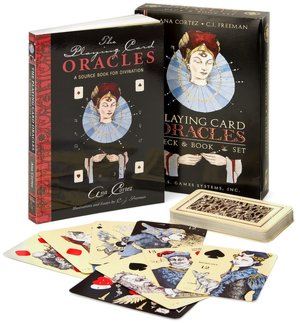
Experienced tarot readers need to get smacked off their chairs every once and a while, metaphysically speaking. After a good shaking up, when they’re back in the chair and spreading cards on a table, there’s a whole new POV to fuel their readings.
If you’re a tarotist who feels stale or is interested in learning a unique method of cartomancy, this is the book to get. The father-daughter team of C. J. Freeman and Ana Cortez (aka Tracy Freeman) developed their ideas about divining with playing cards for two decades. Freeman designed “The Picture Book of Ana Cortez” (a 52-card companion deck), and Cortez wrote this wonderful book.
Structured as Books I and II, each section has different content. Book I, by Ana, fills most of the pages. It describes card symbolism, card handling techniques, spreads, cuts, and an unusual card-generated form of geomancy. Book II is a collection of essays by C. J. Freeman. The first essay gives an excellent account of playing card history, which differs significantly from tarot history. Playing cards are a lot more mystic than people might suspect.
I liked this book a lot because Cortez’s approach is radically different, and not infested with all the ooey-gooey tarot conventions. She works with her wicked pack of cards as a straight-up whiskey [no rocks] fortune-teller. Card meanings are edgier and more overtly predictive. These card meanings aren’t intended for profound psychological insights (although they could have that effect). Readings given in this manner are straight-forward and situational. The Court cards are people, and the pip cards show fairly specific states of being and conditions. These card meanings were developed by the Freemans; some are apparently borrowed or modified from older cartomantic texts, while other meanings are unique to them. Cards are described in numeric order, Ace through Thirteen (i.e. King). The book emphasizes the calendrical ties of the 52-card pack and the lunar calendar, and the time-forecasting potentials of the deck.
There are further benefits from this book. The companion deck, although lovely, isn’t necessary. Any pack of playing cards would work (you still have to memorize card meanings, so sorry, sucks to be you). Another benefit is Cortez’s cartomantic mindset and the obvious spread evaluation techniques that are so often lacking in tarot readers. Almost everything she says about playing card divination can be applied to tarot reading.
Mastering any form of divination takes discipline and practice. But after you’ve mastered a method, it’s all too easy to get into a mental rut. The best thing to do is (metaphorically) put a stick of dynamite in the cerebral cortex, blow it to smithereens and learn a different but related method from scratch. If you’re a contemporary Western astrologer, you do this by learning Vedic or Classical astrology. I’ve seen astrologers jump from Western style to Classical—they looked like they’d been body slammed by John Cena. If you’re a tarotist, you do it by learning cartomancy or some other kind of card oracle from the ground up. Forget everything you know and start over fresh! These are portable skills, folks, and you can carry them back to the Mother Ship. Use these new skills independently or mix and match, it makes no difference. You’ll return to your original method with your eyeballs spinning in new directions.
If you read tarot, this book will make you a better tarotist. If you don’t read tarot and simply want to learn how to read playing cards, this is a book is a terrific starting point (although I’d recommend studying additional texts to examine various meanings and methods offered by other authors). Highly recommended – well-written, well organized, great information. Cortez doesn’t miss a trick (pun intended).
~review by Elizabeth Hazel
Author: Ana Cortez, with illustrations by C. J. Freeman
Book by Tracy Freeman
Twin Sisters Press, 2002
pp. 257, $19.95
